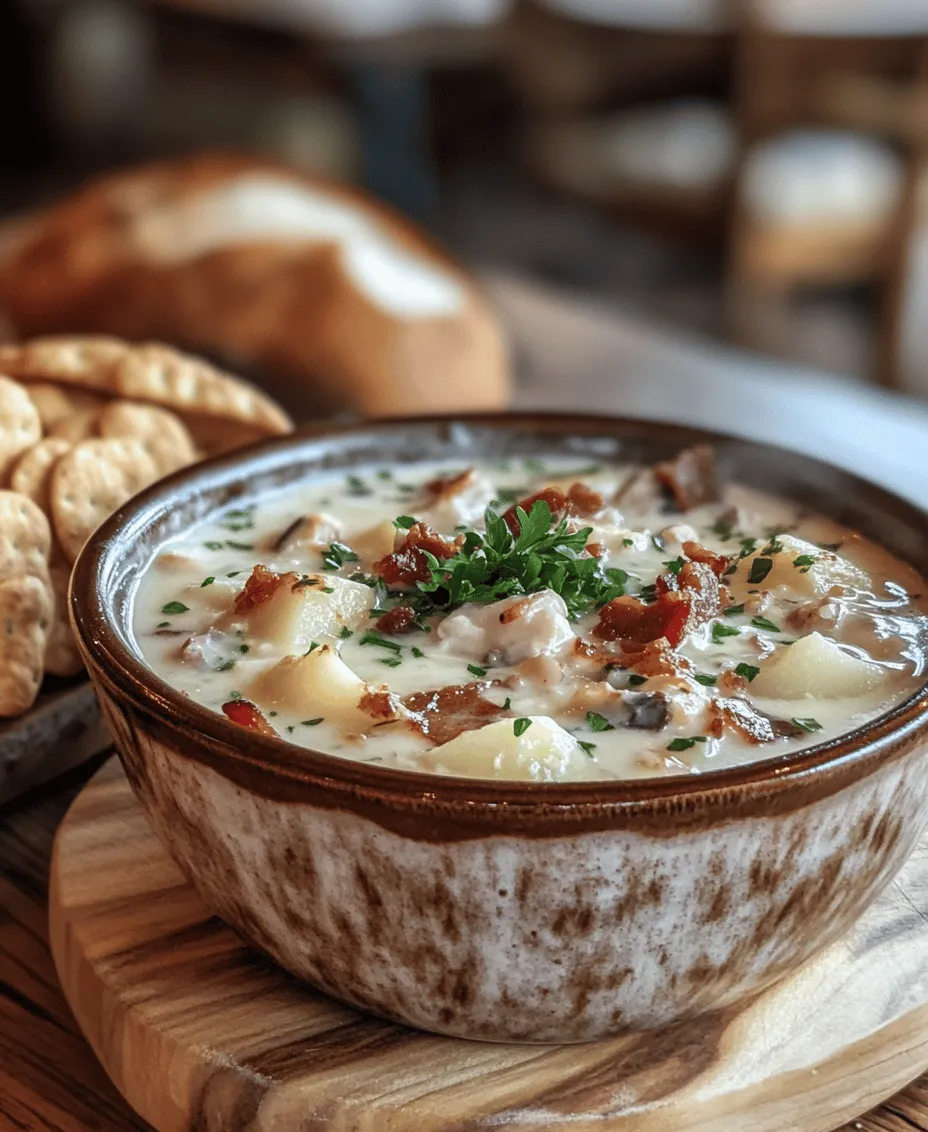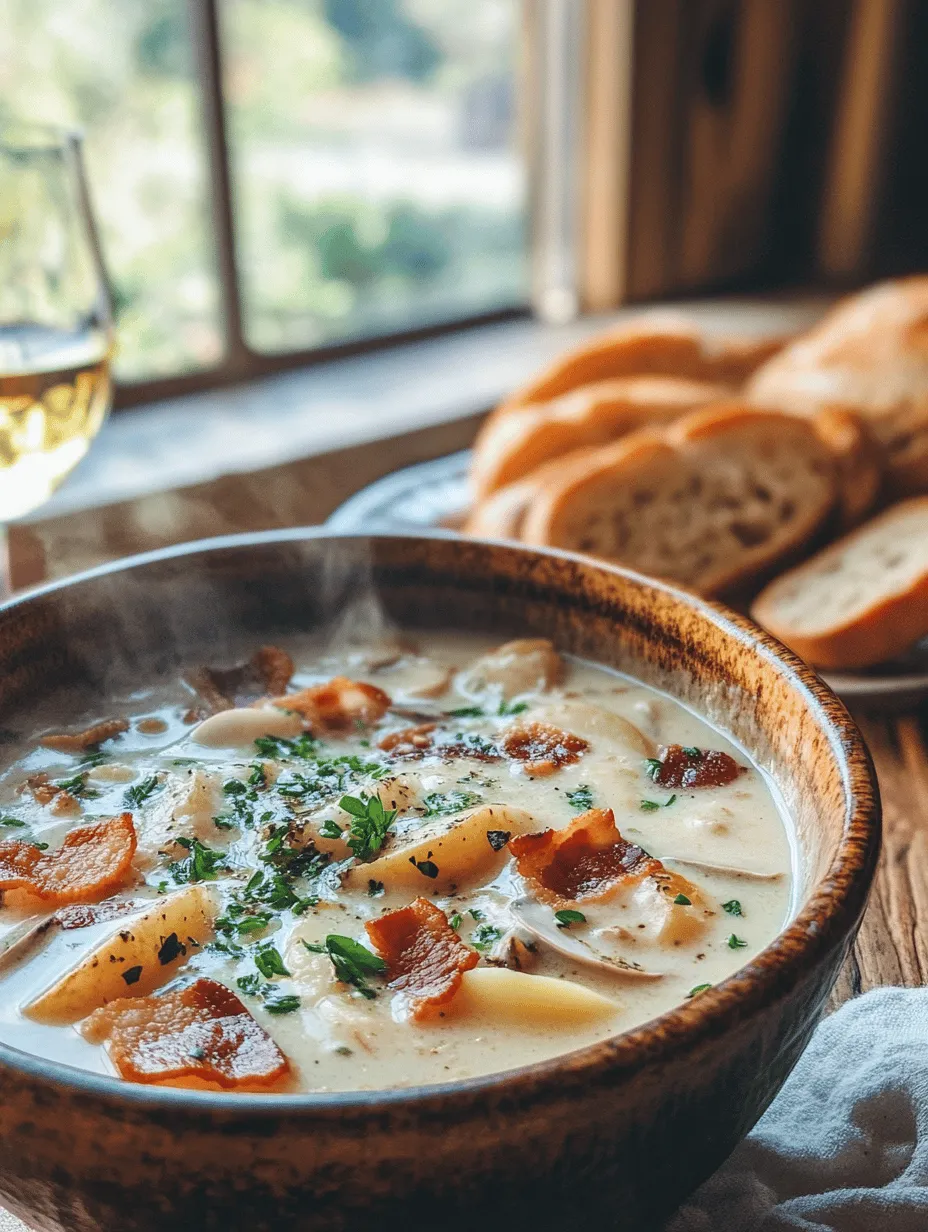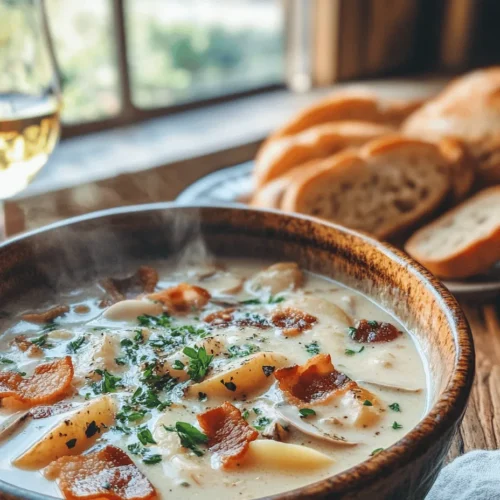Introduction
Welcome to the world of Velvety New England Clam Chowder Delight, a dish that not only comforts the soul but also encapsulates the very essence of New England’s culinary heritage. Known for its rich and creamy texture, this beloved chowder has earned its place as a staple in many households, especially during chilly months when a warm bowl of soup can make all the difference. Whether you’re hosting a dinner party or seeking a comforting meal after a long day, clam chowder is the perfect choice.
In this article, we will dive deep into the heart of this delightful dish, exploring its fascinating history, dissecting the key ingredients that contribute to its iconic flavor, and providing you with a step-by-step guide to crafting your own pot of velvety perfection. This recipe is designed to cater to all cooking levels, ensuring that from beginners to seasoned chefs, everyone can master the art of clam chowder. So, gather your ingredients and prepare to embark on a culinary journey that promises warmth, comfort, and a taste of New England tradition.
The History of Clam Chowder
To truly appreciate Velvety New England Clam Chowder, one must understand the rich history that surrounds this iconic dish. Clam chowder has its roots deeply planted in the coastal regions of New England, with its origins tracing back to the early settlers who arrived in the area. The word “chowder” is believed to have derived from the French term “chaudière,” which refers to a type of pot used for cooking.
The first recipes for clam chowder emerged in the 18th century, primarily made by fishermen who would combine clams with whatever ingredients they could find on their boats. Over time, the dish evolved, with the introduction of milk and cream, which added a luxurious texture to the chowder. By the 19th century, clam chowder became a popular dish in New England and was frequently included in the menus of local inns and restaurants.
As the dish gained popularity, several variations came into existence. The two most well-known types of clam chowder are New England clam chowder, known for its creamy base, and Manhattan clam chowder, which features a tomato-based broth. While both versions are delicious in their own right, New England clam chowder has secured a special place in the hearts of many, thanks to its velvety consistency and hearty ingredients.
The Cultural Significance of Clam Chowder in New England
Beyond its delicious taste, clam chowder holds a significant cultural role in New England. It symbolizes the region’s strong ties to the ocean and its abundant seafood resources. The dish is often associated with local festivals, seafood shacks, and family gatherings, where it is enjoyed alongside freshly baked bread or oyster crackers.
In addition to its role in family meals, clam chowder has become a symbol of New England hospitality. Many restaurants tout their own unique versions, often competing for the title of “best clam chowder,” which adds to the dish’s local lore and pride. Events such as chowder festivals celebrate this culinary staple, showcasing the talent of various chefs and home cooks while drawing crowds from near and far.
Ingredient Breakdown
Now that we’ve set the stage with a bit of history, let’s delve into the essential ingredients that make up Velvety New England Clam Chowder. Each component plays a crucial role in creating the comforting and rich flavor profile that this dish is known for.
Essential Ingredients for Velvety New England Clam Chowder
1. Clams: The star of the show, clams provide the distinct briny flavor that clam chowder is famous for. You can use fresh clams, canned clams, or frozen clams, depending on your availability and preference. Fresh clams offer a more vibrant taste, while canned clams are convenient and still delicious.
2. Bacon: Bacon adds a smoky depth to the chowder, enhancing the overall flavor. The rendered fat from the bacon also serves as a base for sautéing the vegetables, infusing them with that irresistible taste.
3. Vegetables: Onions, celery, and garlic are the holy trinity of mirepoix that form the foundation of many soups, including clam chowder. These vegetables provide both flavor and texture, ensuring that every spoonful is as satisfying as the last.
4. Potatoes: The choice of potatoes is essential for achieving the desired creaminess. Russet potatoes are a popular option due to their starchiness, which helps thicken the chowder and creates a velvety mouthfeel.
5. Clam Juice: This flavorful liquid, often derived from steaming clams, serves as the base for the chowder. It provides a concentrated clam flavor that enhances the overall taste of the soup.
6. Cream and Milk: A perfect balance of cream and milk is crucial for achieving that signature velvety texture. The cream adds richness, while the milk lightens the chowder, ensuring it isn’t overly heavy.
The Role of Bacon in Adding Flavor
Bacon is not merely a flavor enhancer; it is a key ingredient that transforms the chowder into a comforting delight. When cooked, bacon releases its fat, which serves as a base for sautéing onions, celery, and garlic. This combination creates a savory foundation that infuses the entire dish with a depth of flavor. Whether you prefer using thick-cut bacon or smoked varieties, the end result will be a chowder that boasts an irresistible smoky aroma and taste.
Importance of Fresh Vegetables: Onion, Celery, and Garlic
The aromatic trio of onions, celery, and garlic is essential for building the flavor profile of Velvety New England Clam Chowder. Onions provide sweetness and depth, while celery adds a slight crunch and freshness. Garlic introduces a subtle pungency that rounds out the flavors. Together, these vegetables create a balanced base that enhances the overall taste of the chowder.
Choosing the Right Potatoes for Creaminess
When it comes to potatoes, the type you choose can significantly impact the chowder’s texture. Russet potatoes are a favorite among many cooks because they are high in starch, which helps thicken the soup and adds a creamy consistency. Alternatively, Yukon Gold potatoes can also be used for their buttery flavor and smooth texture. Be sure to cut the potatoes into uniform pieces to ensure even cooking.
Understanding the Use of Clam Juice vs. Seafood Stock
Clam juice is a vital component of clam chowder, providing an intense clam flavor. It is typically available in cans or cartons at most grocery stores. If you can’t find clam juice, you can substitute it with seafood stock, which will still impart a seafood essence to the chowder. However, for the most authentic flavor, clam juice is recommended.
The Perfect Balance of Cream and Milk
Achieving the perfect balance of cream and milk is crucial for a velvety chowder. The cream adds richness and body, while milk lightens the overall dish, preventing it from becoming overly heavy. A common ratio is to use one cup of heavy cream to two cups of milk, but feel free to adjust based on your personal preference for creaminess.
Optional Ingredients and Variations
While the traditional recipe for Velvety New England Clam Chowder is delightful on its own, there are plenty of optional ingredients and variations you can explore to make the dish your own.
1. Substituting Ingredients for Dietary Preferences: If you’re looking to make a lighter version, consider using low-fat milk instead of cream. For a vegan alternative, you can replace clams with mushrooms and use coconut milk for a creamy base.
2. Fresh vs. Dried Herbs: A Flavor Comparison: Fresh thyme or parsley can elevate the flavor profile of clam chowder. While dried herbs are convenient and still effective, fresh herbs will impart a brighter taste that truly enhances the dish.
3. Alternative Garnishes for a Creative Touch: Consider garnishing your chowder with crispy fried clams, fresh chives, or a sprinkle of smoked paprika for added depth. Each garnish offers a unique twist that can complement the base flavors beautifully.
The Cooking Process
Now that we’ve covered the ingredients, let’s talk about the cooking process. Preparing Velvety New England Clam Chowder is a simple yet rewarding endeavor. The following steps will guide you through the initial preparations to set you up for success.
Preparation Steps for an Ideal Clam Chowder
1. Gather Your Ingredients: Before diving into the cooking process, it’s essential to have all your ingredients ready. Chop the bacon, dice the onions, celery, and garlic, and peel and cube the potatoes. Having everything prepped in advance will make your cooking experience much smoother.
2. Cook the Bacon: In a large pot or Dutch oven, cook the chopped bacon over medium heat until it becomes crispy. This step not only renders the fat but also provides a delicious base flavor. Once cooked, remove the bacon from the pot and set it aside, leaving the drippings in the pot.
3. Sauté the Vegetables: In the same pot, add the diced onions, celery, and garlic. Sauté them in the bacon fat until they become translucent and fragrant, usually about 5-7 minutes. This step is crucial for developing the soup’s flavor base.
4. Add the Potatoes and Clam Juice: Once the vegetables are softened, add the cubed potatoes to the pot. Pour in the clam juice (or seafood stock) and stir to combine. This will allow the potatoes to soak up the flavors as they cook.
5. Simmer: Bring the mixture to a gentle boil, then reduce the heat to low. Let it simmer until the potatoes are tender, about 15-20 minutes. Stir occasionally to prevent sticking.
By following these initial steps, you will lay a solid foundation for your Velvety New England Clam Chowder. In the next section, we will delve deeper into the remaining cooking instructions, ensuring that your chowder is not only delicious but also perfectly velvety. Stay tuned for more insights and tips that will elevate your chowder-making skills!




